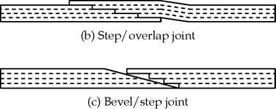Young W. Kwon
Naval Postgraduate School USA
1. Introduction
In recent years, large composite structures have been used increasingly in the aerospace and naval industries. Such a large composite structure is mostly fabricated using the scarf joining technique so that multiple substructures can be connected together. Figure 1 shows three commonly used scarf joint configuration. Among the three, the step/overlap joint is considered as the strongest because it has the largest joint surface area. As a result, this chapter addresses the step/overlap joint. The scarf joint is typically constructed as sketched in Fig. 2. The Vacuum Assisted Resin Transfer Molding (VARTM) technique is frequently used for the joint fabrication process because the technique can be applied to a large size of structure. Furthermore, the scarf joint can be also used for repair of a damaged section.
(a) Step/butted joint
|
|
Fig. 1. Different kinds of scarf joints
Because there is a discontinuity of reinforcing fibers at the joint interfaces as shown in Fig. 2, the scarf joint becomes usually the weakest part of the structure. Therefore, it is important to be able to predict the failure strength of the scarf joint, to enhance the joint strength, and to monitor the progress of failure at the joint before any catastrophic failure. The next section discusses experimental testing of scarf joints as well as Mode I and Mode II fracture testing, which is followed by the computer modeling and simulation section. Subsequently, a technique is described to enhance the strength of the scarf joint interface using Carbon NanoTubes (CNT). After that, a section discusses how to monitor crack growth at the joint interface using CNT. Finally, summaries and conclusions are provided.
(a) Stack layers for the first substructure
(d) Cure the second substructure so that two structures are joined together Fig. 2. Construction of composite scarf join




